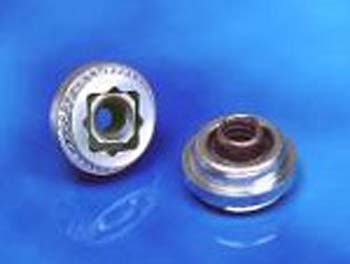Self-Clinching Nuts for Stainless Steel
Welcome to our comprehensive product description for Self-Clinching Nuts for Stainless Steel. In this guide, we will explore the world of these innovative and reliable fastening solutions that provide a secure and permanent method for attaching components to stainless steel sheets or panels. Self-clinching nuts, specifically designed for stainless steel applications, are engineered to be permanently installed by pressing them into pre-punched holes, creating a strong and durable threaded post without the need for additional hardware or tools.
Key Features and Benefits
Self-clinching nuts for stainless steel offer a wide range of features and benefits that make them essential components for stainless steel fastening. Let's explore some of their key advantages:
- Stainless Steel Construction: These nuts are made from high-quality stainless steel, providing excellent corrosion resistance and durability in challenging environments.
- Secure Attachment: Once installed, self-clinching nuts create a strong and permanent threaded post, ensuring a reliable and durable fastening solution.
- Simple Installation: The installation process involves pressing the nut into a pre-punched hole, eliminating the need for additional hardware or tools.
- Space-Saving: These nuts have a low-profile design, optimizing space in assemblies and making them suitable for applications with limited clearance.
- Versatile Applications: Self-clinching nuts for stainless steel are used in industries such as electronics, automotive, aerospace, marine, and more.
- High Strength: Despite their compact size, these nuts offer excellent load-bearing capacity, making them suitable for demanding applications.
- Resistant to Chemicals: Stainless steel nuts offer resistance to a wide range of chemicals, ensuring their performance in harsh environments.
- Resistance to Temperature: These nuts can withstand both high and low-temperature conditions, making them suitable for various applications.
- Cost-Effective: Self-clinching nuts streamline the assembly process, leading to increased efficiency and reduced labor costs.
Types of Self-Clinching Nuts for Stainless Steel
Self-clinching nuts for stainless steel come in different styles and sizes to accommodate various application requirements. Some common types include:
- Blind Nuts: These nuts have a closed bottom end, making them ideal for applications where the bottom side of the panel is not accessible.
- Thru-Hole Nuts: These nuts have a threaded shank that extends through the panel, providing a threaded post on both sides for easy attachment of mating hardware.
- Flush Nuts: These nuts have a flush profile on the visible side, providing a clean and aesthetically pleasing appearance.
- Knurled Nuts: These nuts have a knurled body that enhances grip and makes them suitable for applications where manual installation is required.
Applications
Self-clinching nuts for stainless steel find numerous applications across various industries due to their secure and durable fastening capabilities. Some common applications include:
- Electronics: Used in stainless steel enclosures, electronic panels, and racks for secure fastening of components and equipment.
- Automotive: Found in automotive assemblies for attaching stainless steel interior panels, dashboards, and electronic modules.
- Aerospace and Aviation: Used in stainless steel aircraft interiors, avionics, and cabin assemblies for critical and high-reliability applications.
- Marine: Utilized in stainless steel marine applications for secure attachment of panels, railings, and fixtures.
- Industrial Machinery: Found in control panels, industrial equipment, and robotics for efficient and reliable stainless steel fastening.
- Food Processing: Used in stainless steel food processing equipment for secure fastening in hygienic environments.
- Medical Devices: Employed in stainless steel medical equipment and devices for reliable and durable fastening.
- Architectural: Found in stainless steel architectural elements, such as handrails and decorative panels, for secure attachment.
Installation Process
The installation of self-clinching nuts for stainless steel is a straightforward process that involves the following steps:
- Preparation: Ensure that the stainless steel panel has the correct hole size and design for the specific nut.
- Insertion: Insert the nut into the pre-punched hole in the stainless steel panel.
- Application of Force: Using a press or installation tool, apply sufficient force to the nut to clinch it securely into the stainless steel material.
- Verification: Confirm that the nut is correctly installed and providing a reliable threaded post.
Quality Assurance
At OneMonroe, we take pride in engineering excellence and delivering high-quality self-clinching nuts for stainless steel to our valued customers. Our team of skilled engineers and technicians ensures that each nut meets or exceeds industry specifications. We use advanced manufacturing processes and state-of-the-art machinery to produce stainless steel nuts that provide outstanding performance and durability.
Our self-clinching nuts for stainless steel are thoroughly tested to guarantee their reliability and corrosion resistance, giving you the confidence that your assemblies will perform optimally throughout their service life.
Conclusion
In conclusion, our Self-Clinching Nuts for Stainless Steel offer a robust and corrosion-resistant solution for creating strong threads in stainless steel sheets. With their self-clinching design, these nuts become securely embedded in the stainless steel material, ensuring a permanent and reliable threaded attachment point. Whether you need fasteners for marine applications, food processing equipment, or outdoor installations, our Self-Clinching Nuts for Stainless Steel deliver the durability and performance required for challenging environments. Experience the convenience and reliability of our Self-Clinching Nuts for Stainless Steel by exploring our comprehensive range today.










